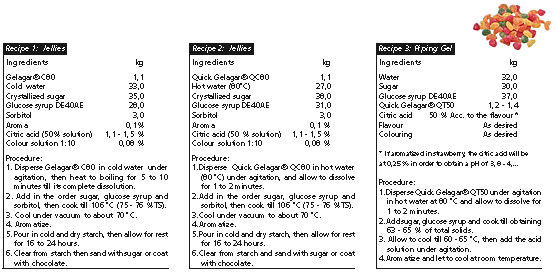 |
|
Heft 01-02 / 2002 
Agar-Agar: an advantageous ingredient for confectionery and bakery industries
Red seaweeds gives texture
To give texture to products, to be adapted to all cooking process, to improve the quality and the shelf life of finished products, to diversify textures when it is associated with other hydrocolloids, to reduce the cooking time without compromising the flavour, are among the benefits that only agar is able to bring to confectionery and bakery industries.

The confectionery and bakery industrial sectors are in growing evolution. On the one hand, the competition offers regularly new confectionery and bakery products which respond to the consumers requirements. On the other hand, the modern circuits of distribution request producers to propose a wide range of each product. Also, the same article will be declined in family with many flavours and colourings and proposed under different forms.
The texture is the principal factor in customer appreciation of confectionery or bakery articles, and the different types of agar produced by the Moroccan company Setexam help to cover a big part of textures requested in those food applications.
Used in a wide range
Thanks to its gelling, thickening and stabilizing properties, agar is used in a wide range of gelled or aerated confectionery such as Jellies, fruit pastry, toffees, soft gums, hard gums, wine gums, marshmallows, angel kisses, Turkish delights, nougats, meringues, etc. In bakery industry, it is used in diversified products such as: piping gel, filling cake, icing, coating, fruit preparations, etc.
Agar is extracted from red seaweeds, of rhodophyceae family and especially from gelidium and gracilaria species.
The European reglementation considers agar as additive, taking E406 code. This texturizing agent is constituted of hydrosoluble galactose chain of which the principal function is to create or stabilize physical and chemical structure of product. In comparison with the all known gelling hydrocolloids, the agar develops the highest gel strength, and forms thermoreversible, strong and firm gels at low dosage without adjunction of salts, sugars or acids.

How to use
Agar is insoluble in cold water, but it swells and can absorb until 5 times its weight of water. It is therefore soluble in boiling water. In gelled confectionery manufacturing, the agar swells and dissolves in pure water in a separated step; the sugar and glucose syrup should be added after the complete dissolution of agar. This dissolution needs an agar/water ratio (w/w) of 1/30 to 1/32 (see recipe 1). On account of those constraints, the agar based gelled confectionery production is made generally in discontinuous batch cooker equipped with under vacuum.
In spite of the flexibility and the easy manipulation of those cookers, some producers prefer to use QSA® (Quick Soluble Agars) that permits to avoid the separated step of swelling and dissolution and which, consequently, reduces significantly the energetic cost and the duration of manufacturing in comparison with the traditional agar (see recipe 2).
In addition, the QSA® dissolution needs only a QSA/water ratio (w/w) of 1/20 to 1/25 which makes possible the production of these gelled confectionery in a continuous process using an over-pressure dissolver of Hamac-Höller (Bosch) type.
Generally, the agar based jellies have a short and brittle texture. However thanks to its versatile character, agar can be combined with other hydrocolloids or with polyols in order to decrease calories, to diversify textures or to create others from short and brittle to long and elastic, allowing thus indefinite new possibilities.
Accordingly, when agar is associated with animal gelatin, the obtained gums have an elastic texture, with a high melting temperature and consequently a high thermal stability thanks to the high gelation hysteresis of agar. The combination of agar with galactomannanes and/or xanthanes allows to obtain a wide range of textures, to avoid syneresis, etc. When agar is associated with starch, it is very efficient to delay or eliminate its retrogradation in many pastry products.
Recently developed by Setexam, the thickening agar range in traditional or in Quick Soluble version has enriched food applications in both confectionery and pastry sectors.
In pastry industry, the thickening agar is used in many applications such as piping gel for decoration, coating, fruit preparations, cake fillings, etc.
In the piping gel manufacturing, this thickening agar permits to obtain an exceptional vaselinuous texture without presence of micro-gels during the manipulation of the finished product (see recipe 3).
In conclusion, the agar ranges, produced by Setexam, used in confectionery and pastry industries are very wide as they are constituted by gelling agars, thickeners, stabilizers, blends with other hydrocolloids, and the choice of adequate quality for each food application depends principally on functional properties requested by users.
Agar is used to texturize or stabilize food products at very low dosage which makes it the more known economical texturizing agent.

Author: Dr. Abdelwahab Riad,
Development & Research, Laboratory Manager, Setexam -The Agar Specialists, El Assam Factory, Usine El Assam,
Route de Tanger, km 7, BP; 210 Kenitra, 1400, Morocco; Phone ++ 212 - 37 - 37 7367, Fax ++ 212 -37 - 37 84 4
|
|
|
|


